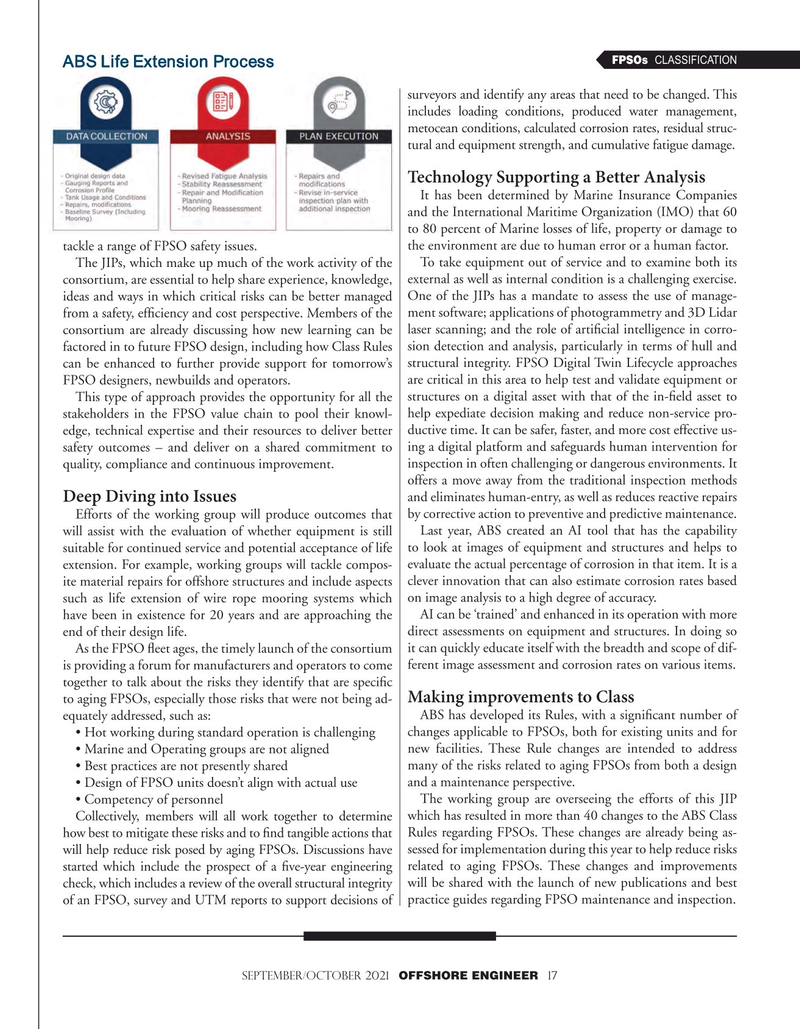
Page 17: of Offshore Engineer Magazine (Sep/Oct 2021)
Digital Transformation
Read this page in Pdf, Flash or Html5 edition of Sep/Oct 2021 Offshore Engineer Magazine
FPSOs CLASSIFICATION
ABS Life Extension Process surveyors and identify any areas that need to be changed. This includes loading conditions, produced water management, metocean conditions, calculated corrosion rates, residual struc- tural and equipment strength, and cumulative fatigue damage.
Technology Supporting a Better Analysis
It has been determined by Marine Insurance Companies and the International Maritime Organization (IMO) that 60 to 80 percent of Marine losses of life, property or damage to tackle a range of FPSO safety issues. the environment are due to human error or a human factor.
The JIPs, which make up much of the work activity of the To take equipment out of service and to examine both its consortium, are essential to help share experience, knowledge, external as well as internal condition is a challenging exercise. ideas and ways in which critical risks can be better managed One of the JIPs has a mandate to assess the use of manage- from a safety, effciency and cost perspective. Members of the ment software; applications of photogrammetry and 3D Lidar consortium are already discussing how new learning can be laser scanning; and the role of artifcial intelligence in corro- factored in to future FPSO design, including how Class Rules sion detection and analysis, particularly in terms of hull and can be enhanced to further provide support for tomorrow’s structural integrity. FPSO Digital Twin Lifecycle approaches
FPSO designers, newbuilds and operators. are critical in this area to help test and validate equipment or
This type of approach provides the opportunity for all the structures on a digital asset with that of the in-feld asset to stakeholders in the FPSO value chain to pool their knowl- help expediate decision making and reduce non-service pro- edge, technical expertise and their resources to deliver better ductive time. It can be safer, faster, and more cost effective us- safety outcomes – and deliver on a shared commitment to ing a digital platform and safeguards human intervention for quality, compliance and continuous improvement. inspection in often challenging or dangerous environments. It offers a move away from the traditional inspection methods and eliminates human-entry, as well as reduces reactive repairs
Deep Diving into Issues
Efforts of the working group will produce outcomes that by corrective action to preventive and predictive maintenance. will assist with the evaluation of whether equipment is still Last year, ABS created an AI tool that has the capability suitable for continued service and potential acceptance of life to look at images of equipment and structures and helps to extension. For example, working groups will tackle compos- evaluate the actual percentage of corrosion in that item. It is a ite material repairs for offshore structures and include aspects clever innovation that can also estimate corrosion rates based such as life extension of wire rope mooring systems which on image analysis to a high degree of accuracy. have been in existence for 20 years and are approaching the AI can be ‘trained’ and enhanced in its operation with more end of their design life. direct assessments on equipment and structures. In doing so
As the FPSO feet ages, the timely launch of the consortium it can quickly educate itself with the breadth and scope of dif- is providing a forum for manufacturers and operators to come ferent image assessment and corrosion rates on various items.
together to talk about the risks they identify that are specifc
Making improvements to Class to aging FPSOs, especially those risks that were not being ad- equately addressed, such as: ABS has developed its Rules, with a signifcant number of • Hot working during standard operation is challenging changes applicable to FPSOs, both for existing units and for • Marine and Operating groups are not aligned new facilities. These Rule changes are intended to address • Best practices are not presently shared many of the risks related to aging FPSOs from both a design • Design of FPSO units doesn’t align with actual use and a maintenance perspective. • Competency of personnel The working group are overseeing the efforts of this JIP
Collectively, members will all work together to determine which has resulted in more than 40 changes to the ABS Class how best to mitigate these risks and to fnd tangible actions that Rules regarding FPSOs. These changes are already being as- will help reduce risk posed by aging FPSOs. Discussions have sessed for implementation during this year to help reduce risks started which include the prospect of a fve-year engineering related to aging FPSOs. These changes and improvements check, which includes a review of the overall structural integrity will be shared with the launch of new publications and best of an FPSO, survey and UTM reports to support decisions of practice guides regarding FPSO maintenance and inspection.
september/october 2021 OFFSHORE ENGINEER 17

 16
16

 18
18